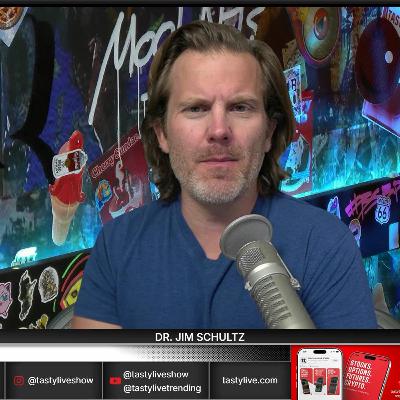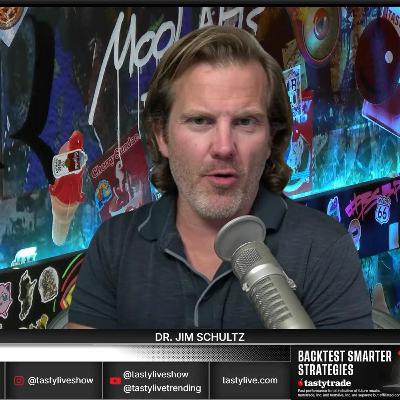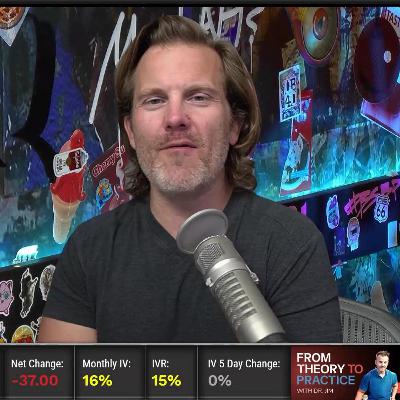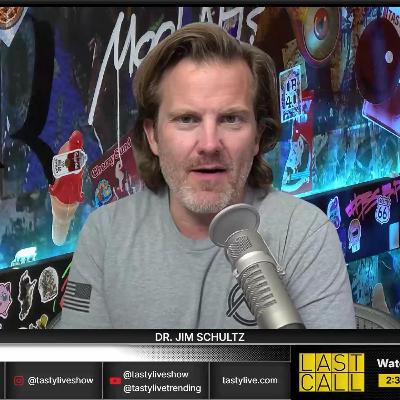Discover tastylive: From Theory to Practice
tastylive: From Theory to Practice

tastylive: From Theory to Practice
Author: tastylive
Subscribed: 1Played: 13Subscribe
Share
© ℗ & © copyright 2013 - 2025 tastylive. All Rights Reserved.
Description
Dr. Schultz (an academic and trader) explains theoretical trading concepts and practical application to take your trading to the next level.
2327 Episodes
Reverse
In today's From Theory to Practice, Dr. Jim examines how much leverage traders should use in derivatives trading, emphasizing the importance of the delta-theta ratio for short delta portfolios. He recommends targeting a 0.5 ratio (one short delta for every two positive theta), with portfolio theta levels between 0.1% to 0.5% of net liquidation value based on experience level, account size and market volatility.
The session highlights how VIX levels should influence position sizing, with higher volatility periods warranting more aggressive theta deployment.
In today's From Theory to Practice, Dr. Jim was shocked to see Domino's Pizza (DPZ) surged 14% as bank earnings season kicked off with Goldman Sachs (GS) and Citigroup (C) reporting. Then, he managed his Home Depot (HD) calendar spread that was closed for a 15% profit, while a new Bank of America (BAC) butterfly position was established ahead of tomorrow's earnings report.
Dr. Jim managed two struggling positions - closing a HIMS position for a minimal loss and adjusting a GDX position by converting to an inverted strangle. He also opened a new short put on the energy index (XLE) at the $85 strike.
With earnings season approaching, traders should prepare for increased opportunities and potential volatility in individual stocks over the coming weeks.
In this educational session of From Theory to Practice, Jim Schultz breaks down undefined risk strategies like short puts, short strangles, ratio spreads, and jade lizards. While these approaches offer superior probabilities and easier adjustments compared to defined risk strategies, they come with the significant tradeoff of unlimited risk exposure and greater complexity.
In today's From Theory to Practice, Jim Schultz explored defined risk strategies for beginner traders, highlighting vertical spreads and iron condors as popular starting points. He emphasized that defined risk's primary advantage is knowing maximum loss at entry, though these strategies offer lower Greek exposure and less flexibility than undefined risk alternatives.
In today's From Theory to Practice, Dr. Jim looks to adjust his PANW Strangle into a Straddle to help improve the break-even point on the upside. With earnings coming up before November expiration, the objective for this position is still to manage it prior to that earnings release.
In today's From Theory to Practice, Dr. Jim continues his deep dive into delta, with a look at using Delta as a measure of directional bias. Arguably, using Delta in this way, either at the individual position level or the overall portfolio level, is the most common way that active traders use Delta. This is likely because Delta can help quickly gauge the approximate directional bias of an individual position or total portfolio at a glance.
In this educational session of From Theory to Practice, Jim Schultz continues his deep dive into Delta by explaining how traders can use it as a probability gauge - the second most common application beyond the textbook definition of measuring option price movement.
Delta serves as an excellent probability approximator in two key ways:
1. **Probability of expiring in-the-money**: This explains why traders typically select 30-35 delta strikes for short options strategies. The inverse (1 minus delta) indicates the probability of expiring out-of-the-money - crucial for premium sellers.
2. **Probability of touch**: Calculated as two times the delta, this measures the likelihood that a price level will be reached at some point before expiration, helping traders assess potential market movements.
In today's From Theory to Practice, Dr. Jim launches a three-part series exploring Delta, beginning with its textbook definition as a measurement of option price movements. While this is how Delta is taught academically, it's actually the least common application for active traders.
Delta represents how much an option's price will move for every $1 movement in the underlying stock. Though often presented as a decimal (0.30), traders typically reference it as a whole number (30 Delta), meaning a $1 stock move leads to a $0.30 option price change.
Long puts and short calls have negative Delta (bearish positions), while long calls and short puts have positive Delta (bullish positions). Understanding these relationships is fundamental for tracking option P&L and making position adjustments.
In today's From Theory to Practice, Jim Schultz analyzes market conditions as gold reaches new highs, suggesting a potential reversal. He executes a downside butterfly spread on gold futures (GC) with strikes at 3855/3820/3785 for a $5 debit, positioning for a possible pullback.
Despite gold's strong uptrend, Dr. Jim points to morning price action showing a $50 dip as a potential "chink in the armor." He also restructures an existing GDX position by rolling a put from the 62 to 70 strike, creating a straddle and collecting $1.39 additional credit.
For earnings, he places a bearish ATM Vertical Spread on Nike (NKE) ahead of after-hours results tonight, buying the 71 put and selling the 67 put for $2.13.
In this episode of From Theory to Practice, Jim Schultz leads off with an announcement that FTTP is moving to five days a week - a gimme to some, but a gotcha to others, for sure.
Then he highlights the potential ramifications of an impending government shutdown and the mixed market signals, such as rising volatility despite a bullish S&P 500. In his portfolio, several trades are reviewed, including Chipotle (CMG) and Costco (COST), alongside a new position in SoFi (SOFI). Dr. Jim then hops on the soapbox to wax poetic about position sizing and flexibility.
In today’s From Theory to Practice, the discussion centered on the negative aspects of Theta in options trading. When buying options, traders incur negative Theta, as time decay impacts their positions adversely. It emphasizes the importance of direction and volatility in generating profits, as time works against option buyers. Additionally, Theta increases as expiration approaches, heightening the costs associated with holding options. The session reinforced the preference for selling over buying options due to these time-related disadvantages.
In today's From Theory to Practice, Jim Schultz discussed the positive side of theta in options trading, emphasizing how option sellers benefit from time decay. When selling options, positive theta creates natural downward pressure on extrinsic value as expiration approaches, improving probability of profit for out-of-the-money positions.
In today's From Theory to Practice, Dr. Jim notes that Fed Funds futures currently price a 96% probability of a 25-basis-point cut and 4% chance of a 50-basis-point reduction. Of course, the market's reaction remains uncertain regardless of outcome, as the anticipated 25-point cut has largely been priced in.
To play the FOMC meeting, Dr. Jim initiated a bearish SPY put spread (buying 663/selling 657) for $3.03, anticipating downside potential following the Fed decision, despite acknowledging his uncanny ability to light stacks of cash on fire for binary events.
Markets remain relatively calm ahead of Wednesday's Federal Reserve rate decision, with the S&P 500 trading near 6666, down 12 points on higher-than-average volume. Traders anticipate a 25 basis point cut, with only a slim 3-4% chance of a 50 basis point reduction. Wheat futures gained significant attention, surging to their highest level since August 18. Several bullish factors support the rally, including increased Asian import commitments, a weaker dollar making U.S. exports more competitive, and USDA raising its wheat export forecast by 1 million tons to 24.5 million. Traders discussed positioning across agricultural commodities, with Thomas holding positions in wheat, corn and soybeans. The group noted that short-covering could accelerate if wheat breaks above the August resistance level of 534.6. Oil remains range-bound between $60-70 despite geopolitical tensions, while the U.S. dollar experienced its worst trading day since August 22.
























